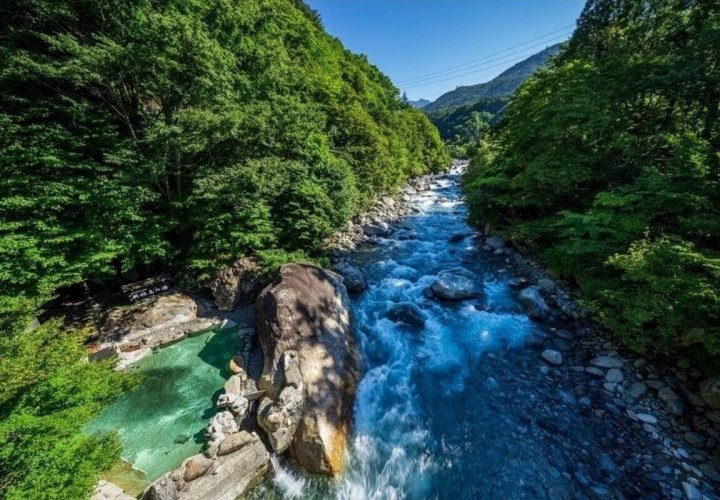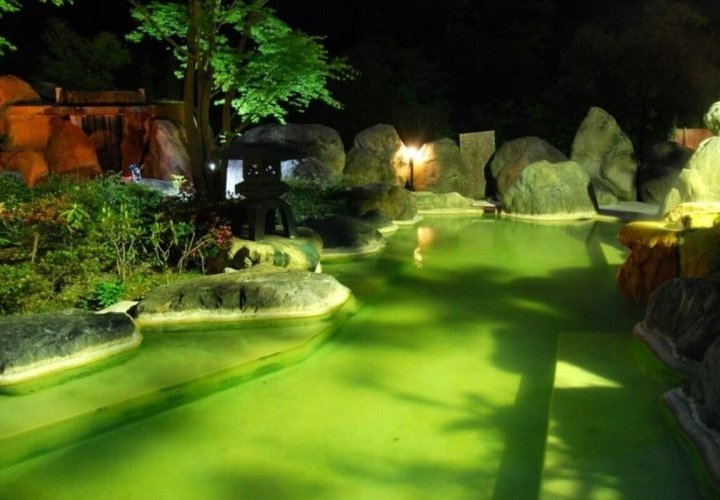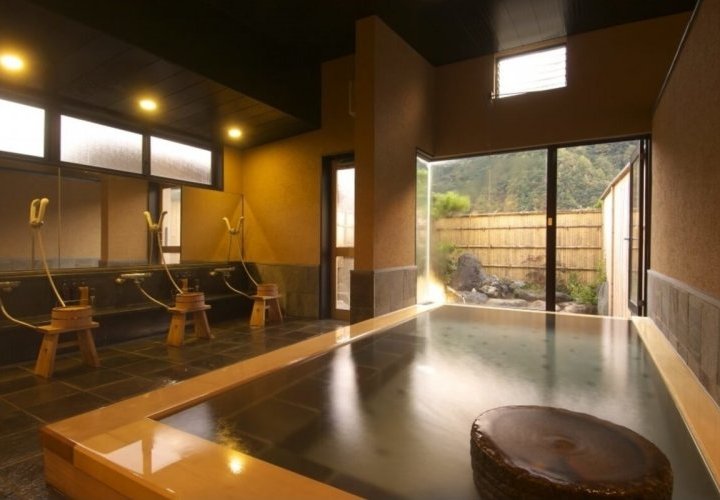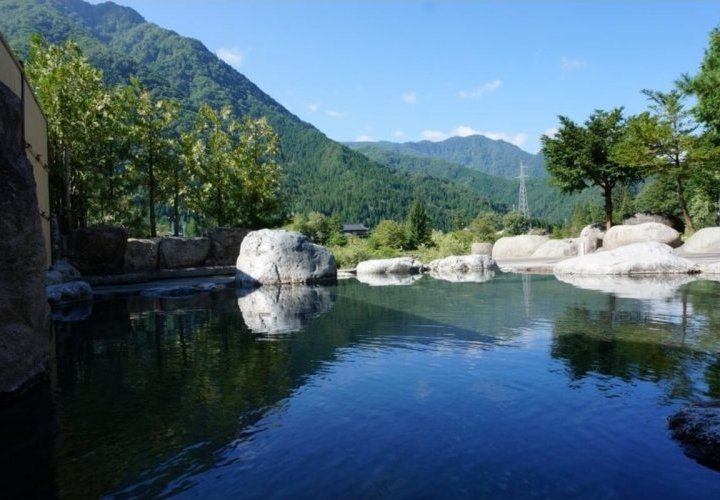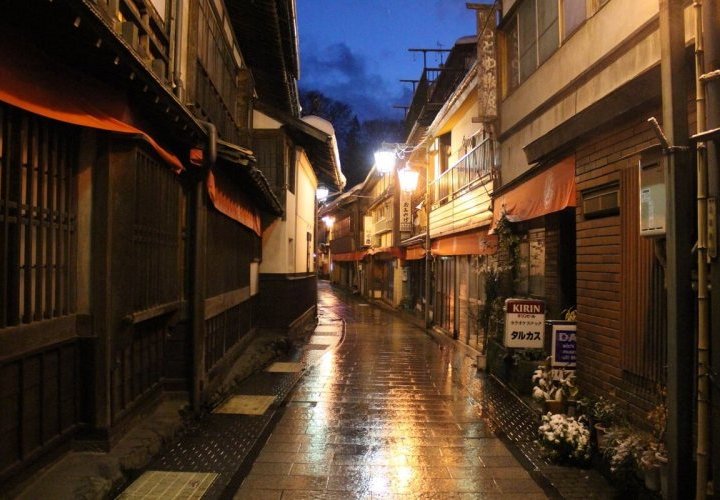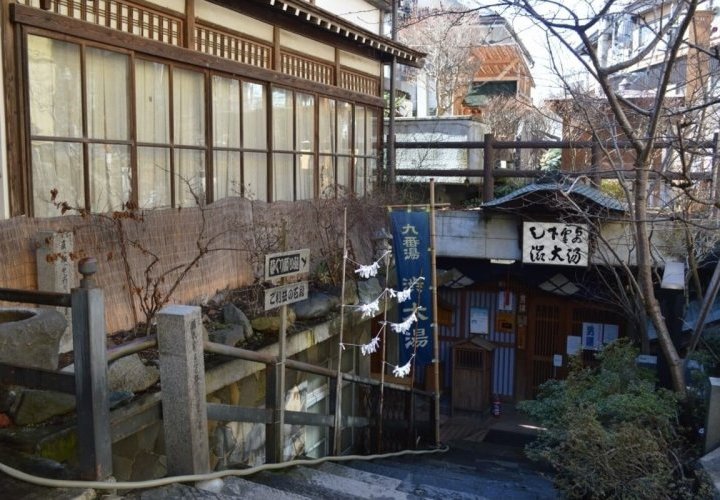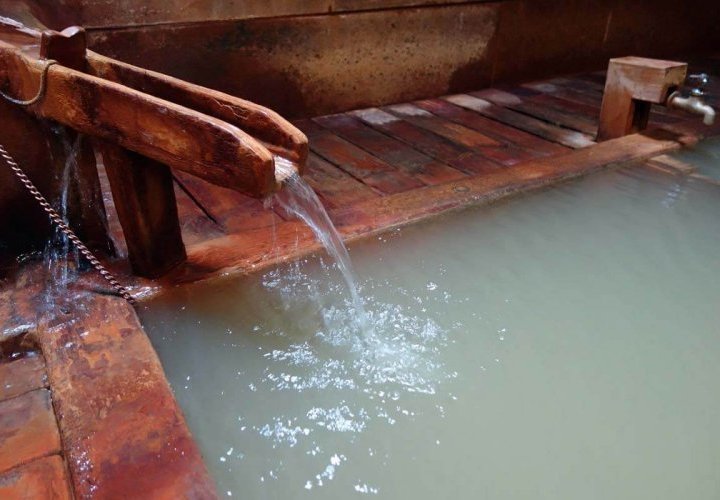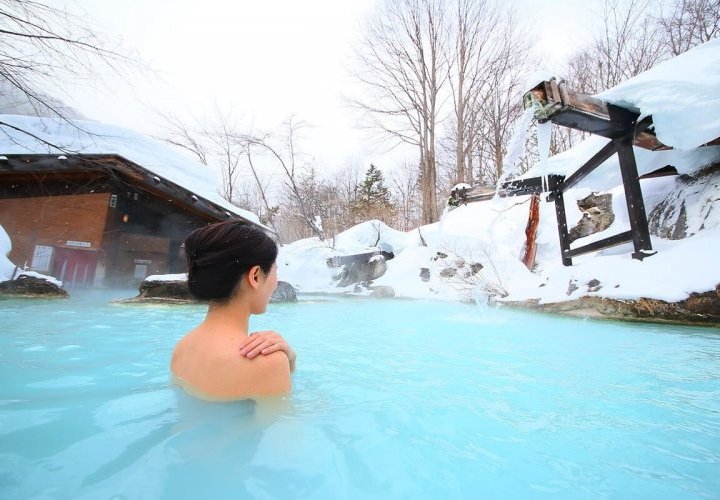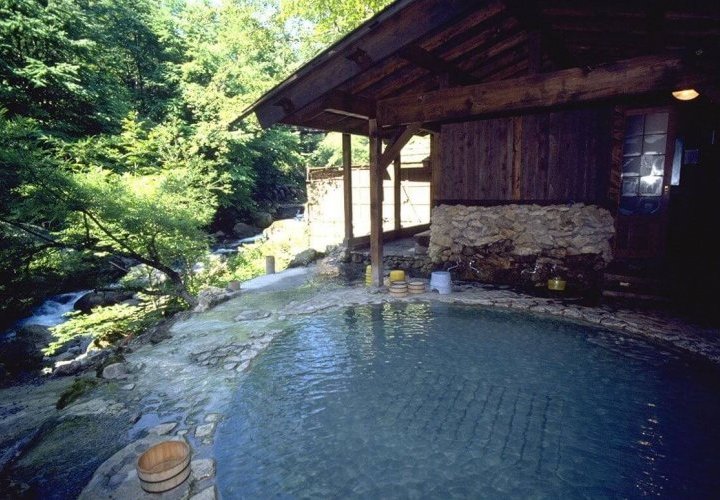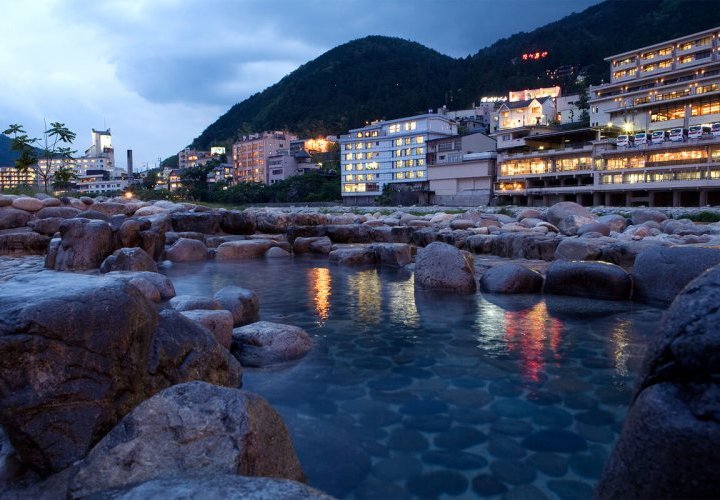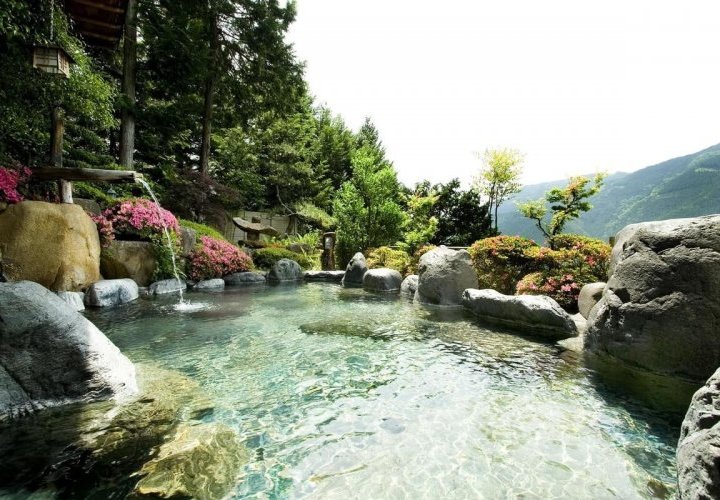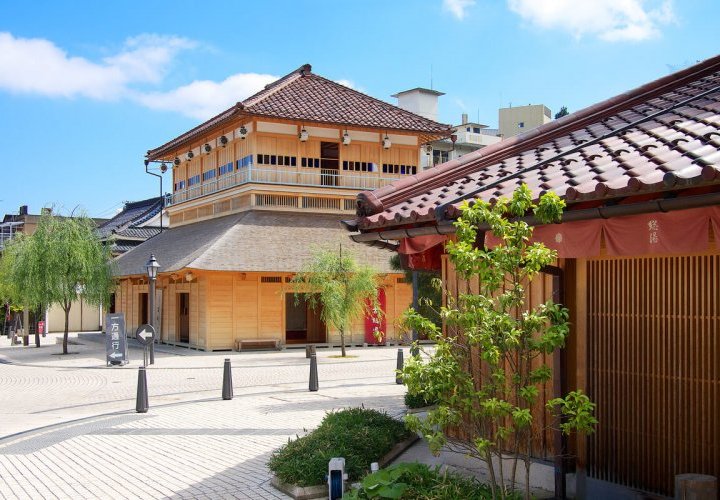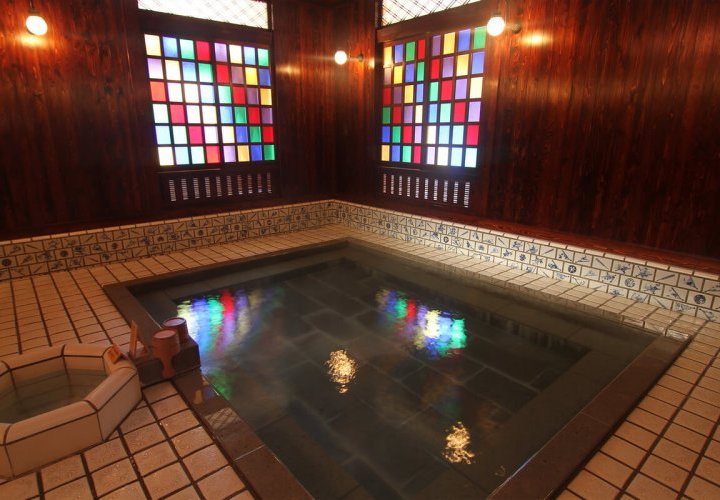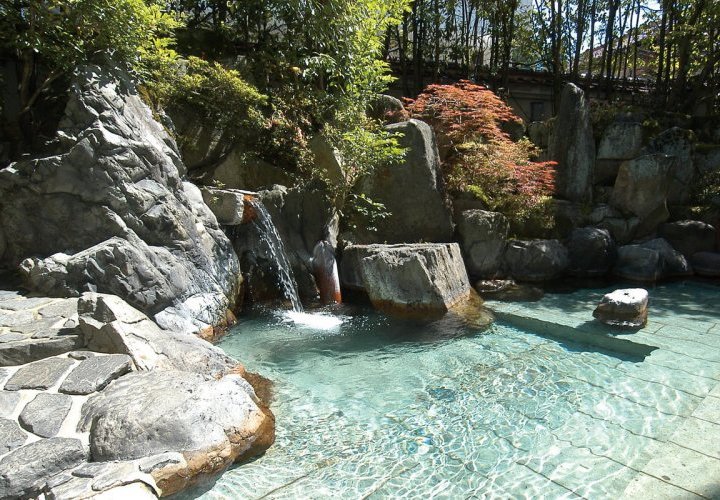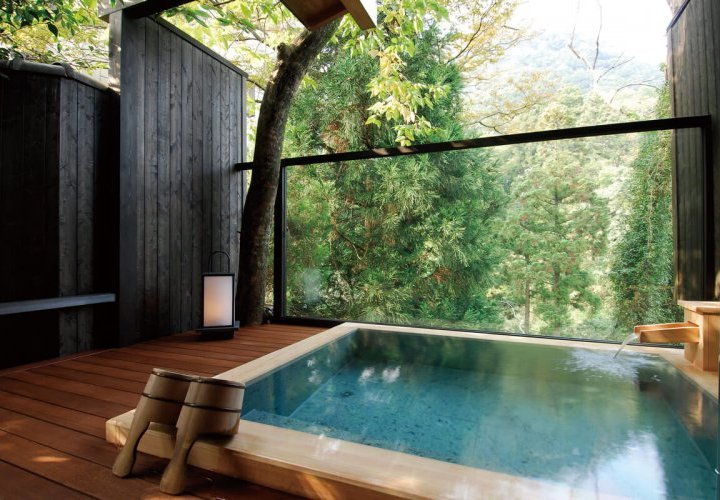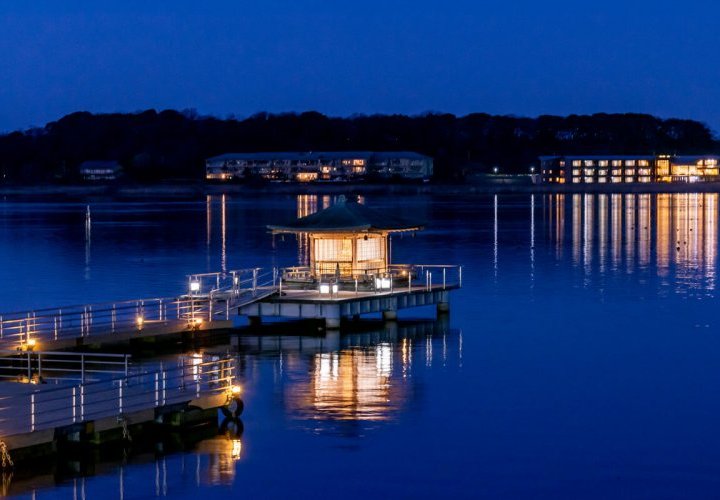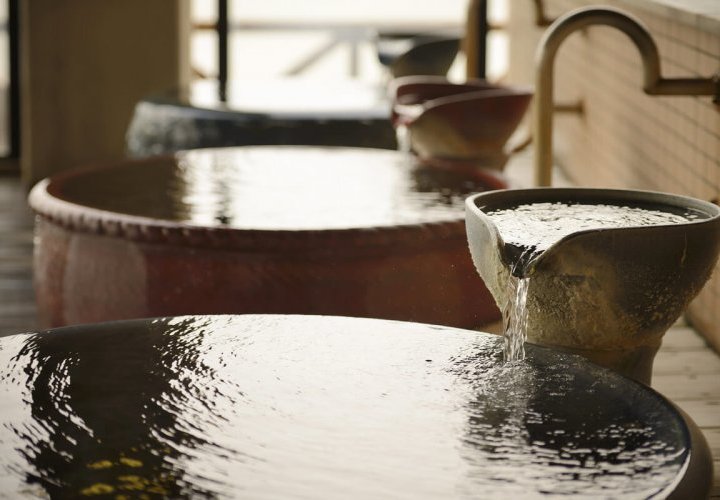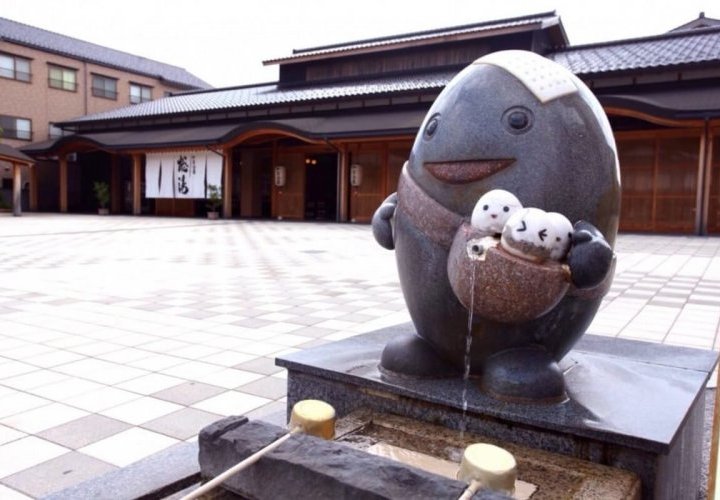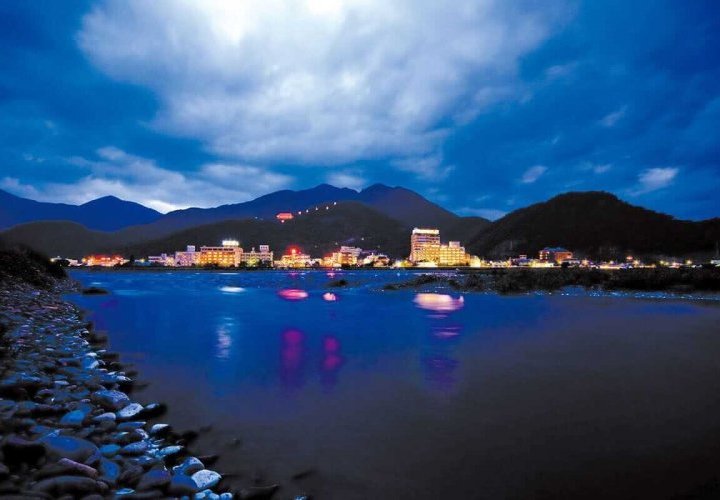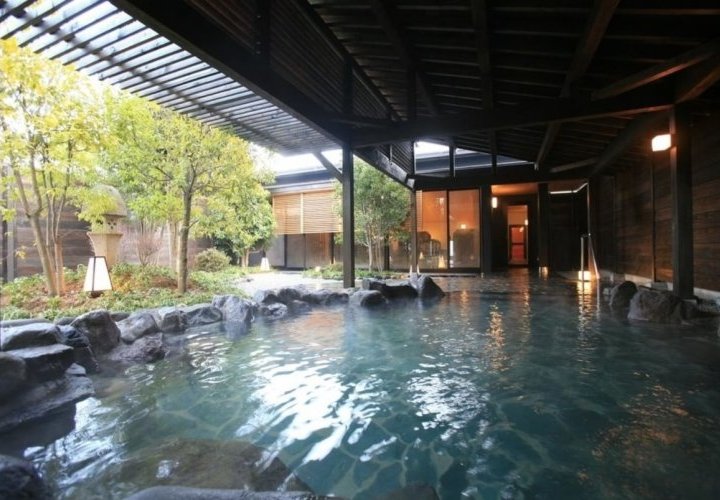Okuhida is a remote region in Gifu Prefecture in a valley deep in the Northern Japan Alps famous for its five hot spring towns with some of Japan’s most spectacular rotenburo (open-air baths), each one with its own unique character and hot spring water. The springs in the area are simple hot springs, chloride springs (healing cuts, burns, and wounds), hydrogen carbonate springs (known as the fountain of beauty for making the skin smoother and helping to solve skin problems) or sulphur springs (dealing with problems such as lifestyle-related diseases).
Okuhida Onsen consists of the following hot springs: Hirayu Onsen that is the oldest and largest of Okuhida’s onsen, Fukuchi Onsen that is the smallest of the five, Tochio Onsen with homely inns, the traditional Shin Hirayu Onsen and Shin Hotaka Onsen with the most abundant springs. more
Okuhida Onsen consists of the following hot springs: Hirayu Onsen that is the oldest and largest of Okuhida’s onsen, Fukuchi Onsen that is the smallest of the five, Tochio Onsen with homely inns, the traditional Shin Hirayu Onsen and Shin Hotaka Onsen with the most abundant springs. more
The towns offer a number of baths, many of which have both segregated and mixed gender bathing.
Shibu Onsen located in Nagano Prefecture is a small onsen town that has a history of as long as 1,300 years. While strolling around the town in your yukata (light cotton kimono), you will feel the atmosphere of an old Japanese onsen town with traditional wooden ryokan and cobblestone paths.
Nine small public bathhouses with different sources and medical effects are scattered around the town. The bathhouses are small buildings with simple baths, divided into a women’s side and a men’s side. They are open to guests already staying at the ryokan, but if you are a short-term visitor, you can enjoy a dip in the hot waters of the town’s largest bath, Oyu, without checking into an inn. The bathhouses have different names and cure different ailments. The minerals found in onsen waters of the baths confer them healing properties: sulphur counters high blood pressure and eases the pain of ailments like arthritis, more
Nine small public bathhouses with different sources and medical effects are scattered around the town. The bathhouses are small buildings with simple baths, divided into a women’s side and a men’s side. They are open to guests already staying at the ryokan, but if you are a short-term visitor, you can enjoy a dip in the hot waters of the town’s largest bath, Oyu, without checking into an inn. The bathhouses have different names and cure different ailments. The minerals found in onsen waters of the baths confer them healing properties: sulphur counters high blood pressure and eases the pain of ailments like arthritis, more
bicarbonate helps to improve skin tone and heal skin conditions and iron confers benefits associated with higher iron content in the bloodstream.
Not far from Shibu Onsen, at Jigokudani Yaen-koen (Monkey Park) you can see wild monkeys bathing in natural hot springs.
Not far from Shibu Onsen, at Jigokudani Yaen-koen (Monkey Park) you can see wild monkeys bathing in natural hot springs.
Shirahone Onsen (literally “white bone hot spring”) is a historical hot spring located in a steep valley in the Northern Japan Alps of Nagano Prefecture. The town has about a dozen ryokan and is known for its milky hot spring water, which has magnesium and calcium sediments and is believed to relieve gastrointestinal ailments, chronic fatigue and stress. The water itself is actually clear, but once it reacts with the oxygen, the hydrogen sulphide and the calcium dissolved in it, it turns white. As a milky white hot spring, which is surrounded by nature and lies near famous alpine nature spots such as Kamikochi and Norikura, Shirahone Onsen has many fans. It is said that the hot spring has over 600 years of history and has been visited by many people to cure their illnesses and injuries over the centuries.
Many of the ryokan in the town open their baths to day trip visitors for a few hundred yen. more
Many of the ryokan in the town open their baths to day trip visitors for a few hundred yen. more
Among them is the Awanoyu with its large mixed outdoor bath (women are allowed to wrap themselves in towels if they wish) and Shirahone Onsen Public Notemburo with its gender segregated-outdoor baths that lie right along the riverside, where you can relax and hear the sounds of rushing water and nature.
Located one hour from Takayama and ninety minutes from Nagoya, Gero Onsen is one of the most famous hot spring resorts in Japan. The location makes it a convenient stopover or an attractive alternative to stay during the Takayama Festival. In the Edo period, Gero Onsen was referred to as one of the three best hot springs in Japan by the Confucian poet Hayashi Razan.
The open-air baths in the ryokan and the spa facilities along the Hida River allow you to relax and enjoy the view of the greenery. At the southern end of Gero Bridge there is also a large rotenburo (open-air bath) where you can bath in for free, but it has no facilities. more
The open-air baths in the ryokan and the spa facilities along the Hida River allow you to relax and enjoy the view of the greenery. At the southern end of Gero Bridge there is also a large rotenburo (open-air bath) where you can bath in for free, but it has no facilities. more
The main type of spring water in Gero Onsen is the alkaline-based one, which is colourless and transparent. The springs are nicknamed the “beauty hot springs” for their property of relieving fatigue, promoting overall health and leaving a smooth skin after bathing. In the neighbourhood, you can find Onsenji Temple that worships Yakushi Nyorai, the Buddha of healing and Gassho Village (Gero Onsen Gassho Mura), an open-air museum of gasshozukuri farmhouses, traditional steep roofed houses from the Shirakawago region.
Kaga Onsen is a collection of four historic hot springs villages located south of Kanazawa (Yamashiro, Awazu, Yamanaka and Katayamazu) and discovered about 1300 years ago by monks visiting Mount Hakusan, one of the “three holiest mountains” of Japan (alongside Mount Fuji and Mount Tateyama). Each village has its own public bath at the town centre.
The best way to explore Kaga Onsen’s hot spring villages is by staying one or two nights at one of the traditional ryokan. You will have the possibility to see the temples, experience traditional Japanese craft art and visit the many footbaths and public baths scattered throughout the neighbouring towns. Alongside the traditional ryokan with their private onsen baths, you will also find a series of low-cost public bathhouses, more
The best way to explore Kaga Onsen’s hot spring villages is by staying one or two nights at one of the traditional ryokan. You will have the possibility to see the temples, experience traditional Japanese craft art and visit the many footbaths and public baths scattered throughout the neighbouring towns. Alongside the traditional ryokan with their private onsen baths, you will also find a series of low-cost public bathhouses, more
known locally as soyu. They are found in the centre of each town and are loved and appreciated by both visitors and locals offering a unique local bathing experience.
Wakura Onsen is a long-standing hot spring resort located beside Nanao Bay at the base of the Noto Peninsula. It has existed as a resort for 1,200 years and was originally discovered by a fisherman who noticed an injured crane bathing its wing in the warm water. In the centre of this hot spring town there is a monument called the “Hot Water Reservoir of Wakura” which commemorates the crane bathing in the ocean. The high-quality springs of Wakura Onsen are considered good for rheumatism, nerve pain, gynaecological diseases, atopic dermatitis and other diseases. The water from the springs is also safe to drink when correctly prepared and can be used to boil hot spring eggs that will have a slightly salty taste.
The best way to enjoy the bathing experience at Wakura Onsen is to spend the night at one of the ryokan. more
The best way to enjoy the bathing experience at Wakura Onsen is to spend the night at one of the ryokan. more
The resort town has large ryokan complexes that offer a wide variety of facilities to their guests, including hot spring baths, restaurants, karaoke rooms, bars and theatres. The most famous of them is the Kagaya Bettei Matsuno Midori ryokan, which ranks among the best ryokan of Japan for its excellent service and facilities. Across from the ryokan, there is a public square (hiroba) with a hot spring water fountain and a small park around a shrine and a hot spring source with water pipes.
The hot spring waters can also be enjoyed by day-trippers, as some ryokan allow non-staying guests to use their bathing facilities during the day for a fee. As a day-tripper, you can also visit Wakura Onsen Soyu, a paid public bathhouse located in town and see Wakutama-kun, Wakura Onsen’s mascot, who will greet you at the entrance. At Wakura Onsen Soyu you can enjoy different baths including warm baths, hot baths, standing baths, open-air baths, saunas, and cold baths, where you will experience concentrated fountainheads constantly gushing with active ingredients that are much loved by hot springs enthusiasts.
The hot spring waters can also be enjoyed by day-trippers, as some ryokan allow non-staying guests to use their bathing facilities during the day for a fee. As a day-tripper, you can also visit Wakura Onsen Soyu, a paid public bathhouse located in town and see Wakutama-kun, Wakura Onsen’s mascot, who will greet you at the entrance. At Wakura Onsen Soyu you can enjoy different baths including warm baths, hot baths, standing baths, open-air baths, saunas, and cold baths, where you will experience concentrated fountainheads constantly gushing with active ingredients that are much loved by hot springs enthusiasts.
Togura Kamiyamada Onsen is a hot spring resort in Nagano Prefecture, located in a valley by the banks of the Chikuma River. On the mountaintop, west of Togura Kamiyamada Onsen stands Aratojo Castle, a reconstructed mountain fortress from the age of warring states (1467-1568). With a history of over 120 years, Togura Kamiyamada Onsen has been a popular stopover for people after visiting the famed Zenkoji Temple in nearby Nagano.
Togura Kamiyama Onsen is known for its simple alkaline hot spring waters that do not have a strong scent and are very gentle to the skin. They are thought to relieve stress, recover from fatigue and improve overall health. The hot spring waters can be enjoyed while visiting several ryokan, seven public baths and a couple of free footbaths, fed by the same hot spring sources. more
Togura Kamiyama Onsen is known for its simple alkaline hot spring waters that do not have a strong scent and are very gentle to the skin. They are thought to relieve stress, recover from fatigue and improve overall health. The hot spring waters can be enjoyed while visiting several ryokan, seven public baths and a couple of free footbaths, fed by the same hot spring sources. more
At some ryokan and restaurants, you can see performances held by geisha that became widely known.

